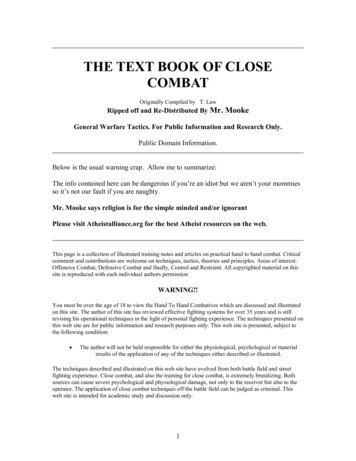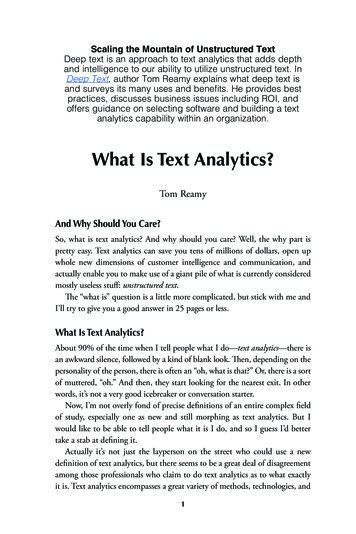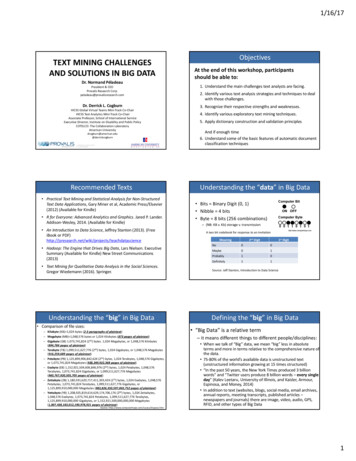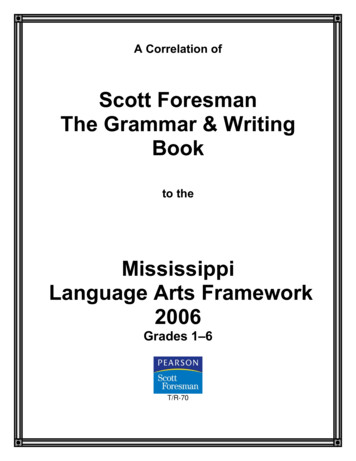
Transcription
THE TEXT BOOK OF CLOSECOMBATOriginally Compiled by T. LawRipped off and Re-Distributed By Mr. MookeGeneral Warfare Tactics. For Public Information and Research Only.Public Domain Information.Below is the usual warning crap. Allow me to summarize:The info contained here can be dangerous if you’re an idiot but we aren’t your mommiesso it’s not our fault if you are naughty.Mr. Mooke says religion is for the simple minded and/or ignorantPlease visit Atheistalliance.org for the best Atheist resources on the web.This page is a collection of illustrated training notes and articles on practical hand to hand combat. Criticalcomment and contributions are welcome on techniques, tactics, theories and principles. Areas of interest:Offensive Combat, Defensive Combat and finally, Control and Restraint. All copyrighted material on thissite is reproduced with each individual authors permissionWARNING!!You must be over the age of 18 to view the Hand To Hand Combatives which are discussed and illustratedon this site. The author of this site has reviewed effective fighting systems for over 35 years and is stillrevising his operational techniques in the light of personal fighting experience. The techniques presented onthis web site are for public information and research purposes only. This web site is presented, subject tothe following condition: The author will not be held responsible for either the physiological, psychological or materialresults of the application of any of the techniques either described or illustrated.The techniques described and illustrated on this web site have evolved from both battle field and streetfighting experience. Close combat, and also the training for close combat, is extremely brutalizing. Bothsources can cause severe psychological and physiological damage, not only to the receiver but also to theoperator. The application of close combat techniques off the battle field can be judged as criminal. Thisweb site is intended for academic study and discussion only.1
THE TEXT BOOK OF CLOSECOMBATCHAPTER's 1 and 2First Steps in Offensive and Defensive Close CombatGeneral Warfare Tactics. For Public Information and Research Only.Public Domain Information.INTRODUCTIONThe purpose of this text book is to present the reader with both offensive and defensiveexamples of close combat.A very wide spectrum of techniques and tactics will be described in this text book. Theoriginal purpose of this approach was to allow the reader to select techniques that suitthem personally and also meet their operational requirements.The techniques described and illustrated in this text book have been used in generalwarfare by Western states from the early 1900's onwards. These armies have always usedclose combat training programmes for two main reasons; First, close combat training promotes fighting spirit and ruthless efficiency.Second, close combat training programmes are the solid foundations for selfconfidence on the battle field.DefinitionsSelf Defence. The amount of physical force used in self defence must be the minimumnecessary to protect either you or others. This degree of force should allow you to eitherescape, ward off or neutralize an attack.Close Combat. To fight and oppose with little regard paid to minimum forcerequirements. The amount of force used will depend on the operational aims. This mayinclude neutralizing, disabling, capturing and killing the enemy.First Steps2
Whenever possible, text book and video studies must be complemented with "hands ontraining" from a competent instructor. First hand accounts from combat veterans will alsogive more credence to the training programme.Standing CombatJoin a boxing, karate or kung fu club and gain valuable contact experience. This mustinclude the practice of timing hits, judging distance, feinting, counter attacking andclosing in for grappling techniques. Do not spend to long learning the one style. Focusingon the one style will create a mind set for that particular style. For example, focusing onboxing may cause you to miss the chance to either kick or throw your opponent when thatopportunity arises.GrapplingJoin a club that specializes in either judo, jujitsu, sombo or wrestling. Here you will learnthe fundamentals of balance, break falling, strangling, choking, limb locking, the mount,the guard and escapes. A good substitute for sound practical hands on instruction in theseareas does not exist.When you are fighting more than one opponent, grappling must be avoided. You willlimit your chances of survival if you allow yourself to be tied up by either applying orbeing caught in body holds or arm lock.A competent ground fighter can be defeated by any of the following quick and lethaltactics; gripping the ear and chopping it off with the free hand, poking out eyes, choppingthe front of the throat or eyes, biting off ears, noses and cheeks.Technical proficiency in either boxing or wrestling or any sport combat is not arequirement for battle field combat. Half a brick or the edge of an entrenching tool to thenape of the neck will work much faster than many years of karate training. Theapplication of these tactics requires nothing more than the will to survive.Safety RulesClose combat training will, at some stage, incur physical injury. This is a fact of life in allareas of combat training. Prior to any combat training, commanders are obliged to predictthe expected loss rate from training accidents. This will ensure that the programme startswith sufficient personnel to offset the training losses.Safety rules will help to reduce the accident rate in your training programme.1. Basic training dress must include rubber soled boots, combat jacket and trousers andfinally, protective body guards. Always use commercial protective equipment that meetsyour training requirements.2. Prior to any training session, a thorough safety check must be made of all dress andequipment. Always check the soles of all footwear and all clothing to ensure that thereare no illegal or foreign bodies attached. Also check that all pockets are empty and noone is wearing jewelry or badges.3. When sparring, restrict all hand and foot attacks to well padded secondary pressurepoints. This procedure will help to reduce training injuries and teach individuals to focusand control their attacks.4. Establish prearranged signals for stopping all activity on the training floor. The signalscan be either verbal or non verbal. The most common signals in general use are eithertwo taps on the training partner or the floor or the shout "Stop!"5. Before practising any technique, always ensure that those involved have a clearunderstanding of their roles.3
6. Practise all new techniques slowly until those involved can control that technique.Speed follows on from a mastery of accuracy and control.7. Never allow new training partners to either train or spar in your group. Give all newpartners a probation period that allows them to master the safety rules and basictechniques.8. Competence in basic first aid is a necessary skill for all those taking part in closecombat training. Transport must also be available to take injured personnel to the nearesthospital.9. No one is allowed to leave the training area without the permission of the instructor.10. Any additions to these safety rules may be dependent on the operationalrequirements.BalanceAll forms of combat have one common denominator, that is, balance. You must strive tomaintain your own equilibrium and try to unbalance your opponent, both mentally as wellas physically. This will make all your techniques much stronger and the opponents muchweaker. The simple act of stepping out of line from their line of attack will unbalance theopponent. If the opponent has grabbed at your upper body, step back and out to the sideto pull them off balance into a defensive mode. If the opponent grabs at your wrist, theact of palm heeling their opposite shoulder will force them to over reach. This can leadyou to using a throwing technique.Ground FightingTraining programmes should be structured so that equal amounts of time are devoted toboth standing and ground combat. There are three main reasons for this.First, either you or your opponent may be punched, clubbed, swept or thrown to theground.Second, in some situations it may be more prudent to go down and attack the opponent'slegs, knees, groin, testicles or bladder.Third, there is always the chance that both you and your opponent will go to the groundtogether.If your experience in ground fighting is limited, then your survival will also be limited.The grounded opponent is not necessarily overpowered or passive. This position can beused to launch many different forms of crippling and lethal attacks that are banned insport combat.When you are fighting more than one person, your survival will be limited. Should youend up in the grounded position, your survival is extremely limited. Offensive anddefensive use of the group will be discussed in other chapters.Lethal TechniquesSport combat systems have excellent safety rules and safe contact techniques. Some ofthe techniques used in sport combat can form the basis of your close combat repertoire.Despite these facts, rigid adherence to the safety rules will produce combatants withlimited practical abilities. This is because the simplest and most lethal techniques in closecombat remain unexplored and unrehearsed.The only way lethal techniques can be incorporated into your training programme is toeither use slow motion drills or direct the lethal strikes to well protected areas. Also, nonlethal pressure point attacks can be directed to various parts of the body. These pressure4
point attacks can be used for both self defence and for setting up lethal attacks. Strangleand choke holds, as well as limb locks can be applied to the submission stage. Thisprocedure will give you a safe and much more realistic approach to practical closecombat.Fighting DistancesIn this text book on close combat, three ranges to be considered. Long range offensive and defensive styles are usually favored by the talleropponent. (See chapter 2)Close range offensive and defensive styles are usually favored by the shorteropponent or wrestler. (See chapter 2 for a more detailed discussion.)Ground fighting is favored by the wrestler. It is also the last option open to thedowned opponent. (See chapter 13 for a more detailed discussion.)DressIn a combat situation, you will be dressed and carrying equipment essential to theoperational task.Unless you have trained in this equipment, you may not be prepared to deal with thissituation.After you have mastered a set of techniques in basic training dress, you must rehearse infull operational dress. This procedure will allow you to appreciate the limitations andrestrictions that operational dress and equipment can impose upon specific techniques.Consideration should also be given to the operational dress worn by the enemy.Fear ControlBefore any boxing match, boxers will experience the physical effects of their mentalturmoil. The fear of physical pain, humiliation, or losing the fight can induce manyphysical side effects.For example, bowel movements will increase in frequency. There can also be incidencesof vomiting or trembling.A detailed discussion on the physiological and psychological effects of battle field fearand its effects would require a chapter on its own. This knowledge would not enhanceyour ability to cope with the disruptive effects that fear can create.Fear is much easier to deal with when it is accepted as mental and physical distress. Thisdistress is created by thinking about the impending combat and all the perceived dangers.Mental and physical distress then creates a nervous energy that is very difficult to control.Paradoxically, this nervous energy is also an essential aid to individual survival. The totalcontrol of fear is neither necessary, nor desirable. The nervous energies created by fearwill tense up the whole body and prepare it for either the fight or the escape. When thehuman body is slightly tense, it can respond much faster than a relaxed body.Physical tension also prepares the body for the impact of the opponent's attack.Simultaneously, fear will increase the individual pain threshold. This allows the body tocope with more trauma than normal. Blood flow to the surface of the skin is reduced.Because of this, bleeding from body wounds is also reduced.The stress of combat will also induce a mental tension. The opponent will be mentallyfocused on the source of the problem and will be operating with a limited level ofconsciousness. Their attention will be directed straight towards you. In this state, the5
opponent will be unable to hear or respond to advice from any source. They will also beunable to see any activity that takes place outside their direct view.Psychological research has shown that individual fears will peak before and after a battle.During the battle, the majority of the combatants can focus on the operational task.Soldiers who are bonded together with a team spirit, well led, believe their cause is justand properly trained, will find it much easier to focus on the operational task.Because of these factors, learning to cope with fear must form an integral part of basiccombat training. The training programme outlined later in this chapter can be used toproduce close combat fighters who can control their fears.Your training programme must also include ways of coping with the limiting mind set offocused attention. Learn to expand your consciousness during training so that you can seeand hear much more than the direct threat.The Adrenalin Rush and The ShakesThe natural reaction of the body to stress is the fight-or-flight emergency response. Asmentioned in the section on fear control, the immediate physiological response is toprepare the body for either fight or flight. This includes an increase of blood flow to thebrain and muscles as well as an increase in strength and energy.If this energy is not dissipated within approximately 10 seconds, through the fight, theenergy is lost through a shaking or trembling process. Your aim in any fight is to attackbefore the energy level peaks. Use that energy boost to defeat the opponent.If the opponent allows their energy level to peak, without fighting, the shakes will set inand they will be incapable of reacting positively.Distracting the OpponentThe ideal time to launch an attack is when the enemy is not prepared for it. Always tryand hit first. When the enemy is either faster, stronger or prepared for your attack,distractions become necessary.The following tacticss may be incorporated into your training programme. As your skilldevelops, you will appreciate the vital fractions of a second and control that thesedistractions allow you.Throw.Throw the nearest object to hand. Make the opponent flinch, blink or stop. This form ofdistraction will give you a fraction of a second to make your own move.Spit.Spitting can make the opponent either blink, vomit, draw back or lift their hands toexpose the lower targets.Spit out anything that happens to be in your mouth at the time of the confrontation.Feint.Before carrying out a definite attack, such as a punch, either pretend to or actually use akick. This tactic will make the opponent act in a predictable manner.Develop your own personal set of combinations.Shout.Shouting and screaming can be used in order to dispel your nervous energy anddisorientate the enemy.By shouting or screaming, you can make the opponent temporarily freeze. The shoutingapproach can also make your own attack much stronger.6
As with all forms of distraction, the enemy may over react or panic. Because of thisfactor, the voice must be used in a controlled manner and immediately followed through.Breathe.Your breathing can also be used to strengthen your attack and confuse the opponent. Thiscan be done by hissing or grunting as you move or attack.Consider the boxer's mode of breath coordinated striking. Just before you strike, youtense up your stomach muscles. Before the strike lands, either grunt, hiss or blow out halfyour lung capacity.Move.In many fights, the opponent will be operating with a limited level of consciousness. Theopponent will both "telegraph" and persist in using the same technique. The simple act ofeither kicking or using a straight arm strangle will induce the opponent to copy you. Boththese situations can be used to your advantage.Combatants are usually motivated by fear or blind hatred. It is not normal for them tothink tactically and respond positively to their opponents attack. Attacks are usuallyfocused on the position of the opponent. The simple act of stepping out of this direct lineof attack can confuse the attacker.Try to remain mobile during a confrontation. This will disrupt the opponents timing andconcentration. If your opponent is circling around you, disrupt their timing by eitherstepping in or out with a side step of your own.If your opponent is right handed, move round them in an anticlockwise direction. Thiswill keep you away from the much stronger right side of their body.At other times encourage the opponent to move forward. Their momentum will add moreimpetus to the force of your attack.Chapter 2 will contain much more detail on this factor.Talk.Talk to the opponent and find out what they want from you. Talking may help to reducethe tension of the situation. It will also leave the opponent more open to attack.Vary the volume and speed of your speech, this will force the opponent to focus on yourvoice.Ambush.Leave the enemy an obvious opening in your defences. Once their anticipated attack isinitiated, you can counterattack.Pretend.Pretend to be afraid, injured, dead, competent, brave, stunned or mad. Do anything todisrupt the thinking processes of the opponent. Create a mental block in the oppositionand then use the opportunity this creates to either attack or escape.SpeedEvery individual varies in the degree of speed they can generate in either offensive ordefensive techniques. This fact is based on the normal physiological differences.Other factors can affect individual speed and reaction times. These include, mentalalertness, physical well being and the quality of individual combat training.In sport combat, reactions can be sharpened up with a warming up session before acontest. An opportunity for this procedure never presents itself close combat. In thissituation, optimum reaction times and positive responses will be dependent on the qualityof the training programme.7
Not all fights will be lost because the opponent is much faster than you. Slow reactionscan be compensated for in many ways. For example, attack first whenever possible, afterthat, use distractions or combination attacks.InitiativeInitiative can be defined, in the military sense, as making the first move. This behaviourwill force the enemy to conform to your movements.Taking the initiative away from the enemy places them in a more vulnerable position.Not only have you taken control of the situation physically, you have also taken a moredominant position at the mental level. All distractions are examples of initiative.Initiative is not just the prerogative of the team leader. It must be fostered in all membersof the team. Individual initiative can be fostered through the employment of a structuredtraining programme. Such a programme must be based on the team mission. It can havebuilt-in problem scenarios that simulate the expected operation.Individual passive or active behaviour in these scenarios should become more innovativerather than indecisive or inappropriate. This training should produce individuallymotivated, self-reliant soldiers who are always thinking one move ahead.ImprovisationImprovisation involves the adaptation of basic techniques, principles and readilyavailable objects to achieve the team mission. The principles of improvisation andinitiative are closely related. Both demand a high degree of flexibility and originalityfrom the thinking processes.The mind set required for initiating action and improvising on the on the battle field canbe enhanced by using a combat orientated training programme.ImpulsivenessOnce you are engaged in combat, there is no time to think about specific forms of attackor defence. Your behaviour must be impulsive and more instinctive. This can only beachieved through contact training with an active training partner.In many sport combat systems, you will receive a grading by displaying standardresponses to standard attacks. In close combat, there are too many variables involved touse such a dogmatic mind set. Your response to an attack must break all the rules, theopponents in particular.After you establish a basic competence in any technique, you must go on to developvariations. This will make your style much more unpredictable, impulsive and instinctive.Do not waste valuable training time by practising in the sterile mode of bag work. Punchbags are useful for developing combination attacks, timing, distance, impact effect andpower.It is imperative that you go on to sparring sessions. Here you can apply combattechniques on a living, moving opponent who is retaliating and exploiting all of yourweaknesses. Your techniques will never be perfect, in this situation, but your impulse toact positively will be much keener. This form of training will also make your reactionsmuch more instinctive.Impact EffectSome forms of sport combat award points for perfect strikes. Because no full contacttakes place, the effects of these strikes are very speculative. In combat situations you willbe faced with someone who moves and even retaliates. Perfect technique is eitherimpractical or may not have the desired effect.8
At times, the enemy may absorb a punishing attack without registering any pain. Thismay be due to either fear, knowledge of impending death, shock, drugs or fighting spirit.It may take four or five strikes to create the desired effect. One strike text book kills mustbe abandoned for a more flexible and sustained assault.Impact effect on your own body must also be explored from two perspectives.First, you must experience the opponents attack in order to assess your ability to absorbthe impact and react positively.Second, when you either hit or miss an opponent, the effect will be entirely different fromthe experience gained on the punch bag. For example, a side kick to the opponent'smidsection can throw them at least eight feet away from you. You may also be propelledback several feet. At this stage, the opponent may be temporarily winded without seriousinjury. They are now at a safe distance from you with time to recover. If you have notexperienced this form of incident, you are in a very vulnerable position. The opponent isdown but far from being out of the fight. This is particularly true for a ground fighter whowill no longer offer you the chance to use your superior kicking.Practice all techniques on an active partner and learn to follow up on everything you do.Direct AttacksFor economy of space, the techniques illustrated in this text book are all direct attacks.Single technique direct attacks are not always successful.Your initial attack can be used as a feint. The feint will allow you to observe how theopponent reacts. Feints can also be used to create an opening. This will be discussed later.Combat Appreciation(S.W.A.T.)The experience of fear, on the battle field, can disrupt you tactical thinking. In combatappreciation, you must learn to focus your attention on four basic factors.The practical consideration of these factors will help you to assess both your situation andthe appropriate course of action. These four factors are:StrengthWeaponsAimTerrain.1. Strength (Numerical and Physical)a) YOU: Your strength depends on how fit you are to handle the situation and howreliable your comrades are.b) THE ENEMY: Is the enemy younger, fitter, faster, fatter, more confident, moreexperienced, or drug crazed? Are they accompanied by comrades or are they close athand?2. Weapons (Legal, Illegal, Improvised and Procured)a) YOU: Have you time to go for a weapon? Is it safe to go for a weapon? Are thereobjects lying around that can be used as weapons?b) THE ENEMY: What weapons do the enemy have? If you can improvise, will they alsoimprovise? Have you adequate defences against their weapons?3. Aim (Purpose and Attitude)a) YOU: Your aim, at all times, will be survival at any cost. How you achieve thisdepends on your appreciation of all the other factors.9
b) THE ENEMY: Your opponents aim can include detaining, crippling, raping or killingyou. It is up to you to find out fast, by arguing, observing, moving, listening, talking,cooperating, thinking and distracting.4. Terrain (Surface Conditions and Troop Disposition)a) YOU: Are you in an area that is familiar to you? Can you use the ground to youradvantage? What type of tactics can you use on that terrain to escape or stay alive?Where is the nearest refuge? Can you step, roll or fall without danger? Where is yournearest back up?b) THE ENEMY: Is this their territory? From which direction will their support come?Consideration of these four factors will help you to survive.QuarterIn a boxing match, when your opponent falls, you immediately go to a neutral corner.This scenario does not occur in close combat. When your opponent falls, this simplyindicates the next phase of the fight. Always continue the fight until your survival isguaranteed.Never give the opponent the opportunity to recover. Never expect quarter and never giveit until your operational aim has been achieved.Nerve PointsThe illustrations in chapter 2 show 32 frontal and 17 rear targets on the human body. Notvery many people will have the clarity of mind, in the heat of the fight, to rememberthese precise points.Just remember that the maximum damage pressure points lie down the centre line of thebody from between the eyes to the pubic area. This centre line is usually well defendedwith body armour or the opponents forearms. The best way to get to the vulnerable areasof the body is to attack either side of the centre line to open up the opponents defence,then attack the centre.You can also work your way around the opponent and attack the rear areas.In the heat of the fight, there is a low probability of striking the vulnerable areas withaccurate and powerful strikes. Consider using combination attacks to weaken theopponent and break down their defences.Hand TechniquesThe bones of the hand are very delicate and easily damaged. Most people have a naturaltendency to clench their fists in violent situations. Because of this fact, some closed fisttechniques have been described in this textbook. The fist must only be used when it isprotected by heavy duty gloves or knuckle dusters. This will be discussed in much moredetail in Chapter 3.Defensive StancesThink about this point. If you have the time to adopt a defensive stance, it means that anattack on your person has been either unsuccessful or you have time to perceive an attackon your person and time to adopt a stance.On many occasions your perception of an attack will be preceded by a feeling of semiconsciousness after a surprise attack or else your body hurtling to the ground after a rearattack.Stances are secondary to learning how to run from, duck, dodge and parry attacks as they10
occur. Stances are also secondary to learning how to break your fall and carry out adefence from the ground.If you have time to perceive an attack, that time would be better spent either escaping orelse attacking, rather than presenting a static target and the static mind set that stances canencourage.Use stances as part of your distracting techniques. For example, adopt a boxers stanceand use your feet.Despite these points, stances for stick, knife and unarmed situations will be discussedfurther in Chapter 2.Foot TechniquesIn sport combat, many foot attacks are directed at difficult to reach areas. For safetyreasons, kicks are never allowed to the most vulnerable areas. These areas include theankles and sides of the knee cap.Try and keep your kick and sweeps low where they are at their most powerful. Thisapproach will keep you away from the opponent's hand and grappling techniques.The terrain you are fighting on will restrict the type of foot techniques you can use. Try torevise foot techniques on a wide variety of terrain.Body MovementText book illustrations always fail to convey the degree of body movement involved inany technique. The figures used in illustrations can only represent a single phase of aphysical action. Do not slavishly follow the illustrations. It is important that you modifythe techniques illustrated in order to suit your height, dress and situation.In close combat, you must move continually. Keep stepping both in and out of theopponent's line of attack. This will disrupt their timing. Also sway, bob and weave inorder to avoid strikes. Body movement is the priority in avoiding attacks. This is becauseducking and dodging is much more instinctive than blocking techniques.Holding the OpponentGrabbing or holding the opponent will place you at a disadvantage. With your handsemployed, your defences are restricted. This is particularly true when you may have tofight with more than one person. Always weaken or distract the opponent before trying toapply a hold. When you go for a hold, try to apply it to the hair, ears, testicles, throat orfingers. Also use pincer grips, arm and leg locks, chokes and strangles.The application of holds depends on the successful use of distractions and combinations.Holding a WeaponHolding a weapon can place you at a disadvantage, if you are focused on looking for anopening to use that particular weapon.The weapon can also be used as a distraction by you. While the opponent is focused onthe weapon, attack by any other means.Unconventional TechniquesSurvi
THE TEXT BOOK OF CLOSE COMBAT CHAPTER's 1 and 2 First Steps in Offensive and Defensive Close Combat General Warfare Tactics. For Public Information and Research Only. Public Domain Information. INTRODUCTION The purpose of this text book is to present the reader with both offensive and defensive examples of close combat.










